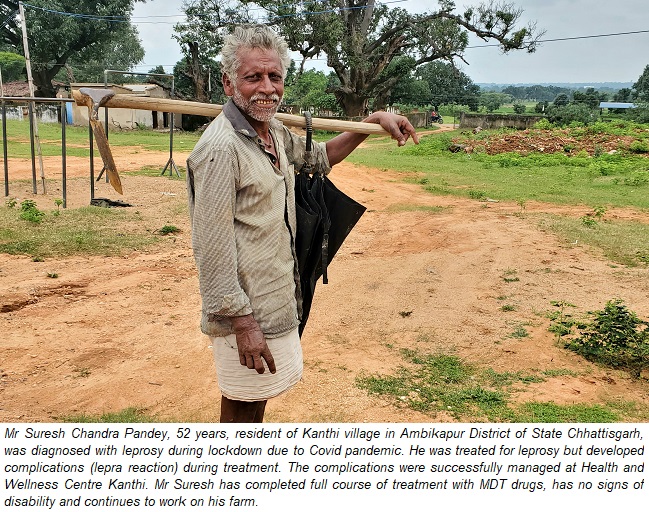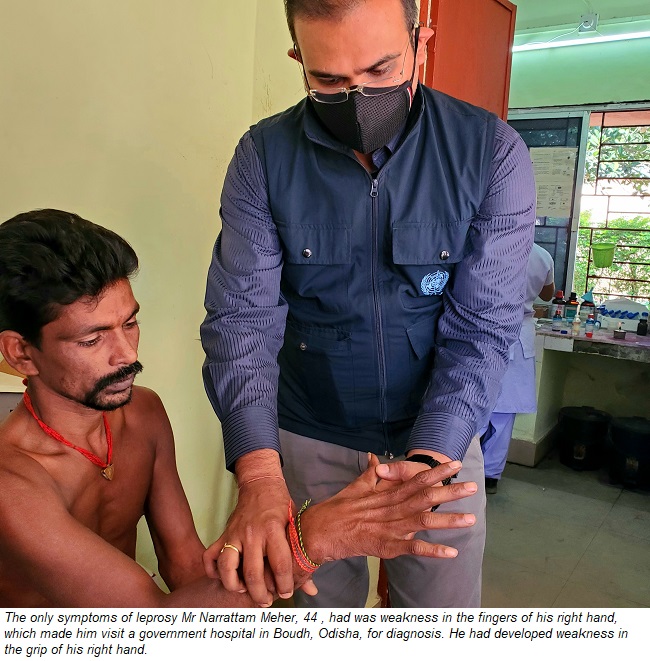When Mr Narrattam Meher, 44, developed weakness in the fingers of his right hand, he immediately visited the District Headquarter Hospital in Boudh in Odisha, a coastal state in eastern India. “I had no other symptoms, but I could not hold up food to eat. I’m a weaver, and it worried me,” said Mr Pradhan.
At the hospital, he was counselled by the WHO Neglected Tropical Disease (NTD) officer, who informed him that disabilities may develop due to leprosy. Leprosy is a chronic infectious disease caused by Mycobacterium leprae. The disease mainly affects the skin, the peripheral nerves, mucosa of the upper respiratory tract, and the eyes. Leprosy causes light-coloured patches on the skin with loss of sensation in the early stages of the disease. If left untreated, advanced disease includes weakness or paralysis in muscles of hands, feet, face and eyes, ulcers in the soles of the feet and blindness. Leprosy is curable and treatment in the early stages can prevent disability.

The World Health Organization (WHO), working through the country office in India, supports the National Leprosy Eradication Programme (NLEP). WHO ensures uninterrupted supply of the specific drugs needed for multi-drug combination treatment (MDT) of leprosy. WHO also assists in planning, capacity building, community education, monitoring and supervision, preparedness for campaigns and supporting monitoring of service quality. WHO NTD state and zonal coordinators provide technical support to states and districts to implement the national programme.
Under the NLEP, active case detection and regular surveillance under the Leprosy Case Detection Campaign (LCDC), ASHA-based Surveillance for Leprosy Suspects (ABSULS), Active Case Detection and Regular Surveillance (ACDRS) are being conducted to interrupt transmission of the causative organism Mycobacterium leprae.
The active case detection activities aim at early identification of suspected cases in the community for prompt diagnosis and treatment. Countrywide awareness drives at the village level are conducted every year under the SPARSH Campaign to educate communities, stop stigma and discrimination and find people who may be infected and link them to health care services.

In addition, the expansion of leprosy post-exposure prophylaxis (LPEP) treatment using the single-dose rifampicin is underway. The LPEP initiative was implemented after successful outcomes of the feasibility implementation study in the Union Territory of Dadra and Nagar Haveli in western India. In this study, household, social contacts and neighbours of persons newly diagnosed with leprosy were systematically traced by health services, linked for leprosy screening, and if they are found to be affected – provided with single dose rifampicin (SDR).
The study registered 1 662 infected persons (called index cases) and on average, traced 26 contacts of each index case. Screening was conducted for 42 333 contacts (97.8% of those listed) and 42 cases of leprosy were confirmed among them. The new case detection rate per 10 000 contacts was 10. Of the contacts, 30 295 (71.6%) were eligible and provided SDR treatment. Prior to the start of the COVID-19 pandemic in 2020, more than half a million contacts were screened annually and about 65% of them were administered SDR treatment.
Leprosy is endemic in several states and union territories of India, with the annual case detection rate of 4.56 per 10 000 population. The prevalence rate of leprosy is 0.4 per 10,000 population in the country. Of the new cases detected during 2020-2021, 58.1% were multibacillary, 39% were women, 5.8% were children less than 14 years of age, and 2.41% had visible deformities. The rate of visible deformities was 1.1 per million population.
In March 2021, 79 898 patients were under free MDT treatment for leprosy across the country. Despite COVID-19 disruption of health services during 2020-2021, 65 147 new cases of leprosy were identified, diagnosed and provided free treatment. Continuity of these essential healthcare services during pandemic response ensures that leprosy is cured and disability is prevented.
